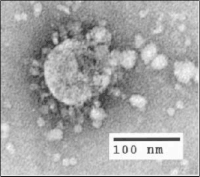
Photo from wikipedia
Early and accurate detection of SARS-CoV-2 is important for diagnosis and transmission control. The use of high-throughput and automated testing allows laboratories to better deliver diagnostic testing given manpower and… Click to show full abstract
Early and accurate detection of SARS-CoV-2 is important for diagnosis and transmission control. The use of high-throughput and automated testing allows laboratories to better deliver diagnostic testing given manpower and resource limitations. We validated the clinical and analytical performance of the Hologic Panther Aptima SARS-CoV-2 assay with an emphasis on detection of specimens with low viral loads. The clinical performance was evaluated using 245 clinical specimens, against a comparator PCR-based laboratory developed test (LDT). The analytical performance was determined by replicate testing of contrived samples in a ten-fold dilution series (CT values 32–42, based on LDT). The Aptima assay had 96.7% overall percent agreement, 100% negative percent agreement and 88.1% positive percent agreement. It was able to consistently detect SARS-CoV-2 in contrived samples with CT = 32 by LDT (calculated 2354 copies/mL). The 95% limit of detection of the Aptima assay was estimated to be at LDT CT = 33 (equivalent to 870 copies/mL). The relative light units (RLU) × 1000 for 52 true positive clinical specimens was 962.2 ± 181.5, and that for the 186 true negative specimens was 264.6 ± 14.3. The Aptima assay was a reliable method with a high overall percent agreement against our comparator LDT. We propose that samples reported as negative by the Aptima assay with RLU > 350 be tested by a secondary method, in order to improve detection of samples with very low viral loads. Supplementary Information The online version contains supplementary material available at 10.1007/s00284-021-02730-3.
Journal Title: Current Microbiology
Year Published: 2021
Link to full text (if available)
Share on Social Media: Sign Up to like & get
recommendations!